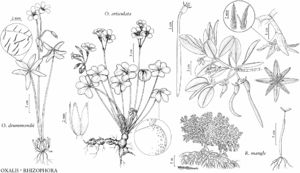Difference between revisions of "Rhizophoraceae"
FNA>Volume Importer |
FNA>Volume Importer |
||
| Line 19: | Line 19: | ||
--><p>Bruguiera gymnorrhiza (Linnaeus) Savigny (large-leafed orange mangrove), native to the Indian and western Pacific Islands, has been found as an escape in Miami-Dade County, Florida. It is considered invasive in Florida and efforts are underway to eradicate it. Bruguiera may be distinguished from <i>Rhizophora</i> by its 8–16 sepals and petals and lack of aerial stilt roots.</p> | --><p>Bruguiera gymnorrhiza (Linnaeus) Savigny (large-leafed orange mangrove), native to the Indian and western Pacific Islands, has been found as an escape in Miami-Dade County, Florida. It is considered invasive in Florida and efforts are underway to eradicate it. Bruguiera may be distinguished from <i>Rhizophora</i> by its 8–16 sepals and petals and lack of aerial stilt roots.</p> | ||
|tables= | |tables= | ||
| − | |references= | + | |references={{Treatment/Reference |
| + | |id=graham1964a | ||
| + | |text=Graham, S. A. 1964. The genera of Rhizophoraceae and Combretaceae in the southeastern United States. J. Arnold Arbor. 45: 285–301. | ||
| + | }}{{Treatment/Reference | ||
| + | |id=tomlinson1986a | ||
| + | |text=Tomlinson, P. B. 1986. The Botany of Mangroves. Cambridge. | ||
| + | }} | ||
}}<!-- | }}<!-- | ||
| Line 36: | Line 42: | ||
|illustration copyright=Flora of North America Association | |illustration copyright=Flora of North America Association | ||
|distribution=Nearly worldwide;tropics and subtropics. | |distribution=Nearly worldwide;tropics and subtropics. | ||
| − | |reference= | + | |reference=graham1964a;tomlinson1986a |
|publication title= | |publication title= | ||
|publication year= | |publication year= | ||
|special status= | |special status= | ||
| − | |source xml=https://jpend@bitbucket.org/aafc-mbb/fna-data-curation.git/src/ | + | |source xml=https://jpend@bitbucket.org/aafc-mbb/fna-data-curation.git/src/f50eec43f223ca0e34566be0b046453a0960e173/coarse_grained_fna_xml/V12/V12_174.xml |
}}<!-- | }}<!-- | ||
-->[[Category:Treatment]] | -->[[Category:Treatment]] | ||
Revision as of 19:51, 16 December 2019
Shrubs or trees, evergreen, synoecious [dioecious]. Leaves opposite, simple; stipules present, interpetiolar; petiole present; blade margins entire [serrulate near apex]; venation pinnate. Inflorescences axillary, cymes [fascicles or flowers solitary]. Flowers bisexual [rarely unisexual]; perianth and androecium perigynous [hypogynous or epigynous]; hypanthium completely adnate to ovary [adnate to ovary proximally and free distally, or absent]; sepals 4[–16], distinct or connate basally, valvate; petals 4[–16], distinct; nectary present [absent]; stamens [4 or]8[–32], distinct [connate basally], free; anthers dehiscing by adaxial valve [longitudinal slits]; pistil 1, 2[–5(–20)]-carpellate; ovary 1/2-inferior [superior to inferior], [1–]2[–5(–10)]-locular, placentation apical-axile; ovules 2[–8] per locule, anatropous [hemitropous]; style [0–]1; stigmas [1–]2[–4]. Fruits berries [capsules or drupes]. Seeds 1 per fruit [1 per locule].
Distribution
Nearly worldwide, tropics and subtropics.
Discussion
Genera 17, species ca. 120 (1 in the flora).
Bruguiera gymnorrhiza (Linnaeus) Savigny (large-leafed orange mangrove), native to the Indian and western Pacific Islands, has been found as an escape in Miami-Dade County, Florida. It is considered invasive in Florida and efforts are underway to eradicate it. Bruguiera may be distinguished from Rhizophora by its 8–16 sepals and petals and lack of aerial stilt roots.
